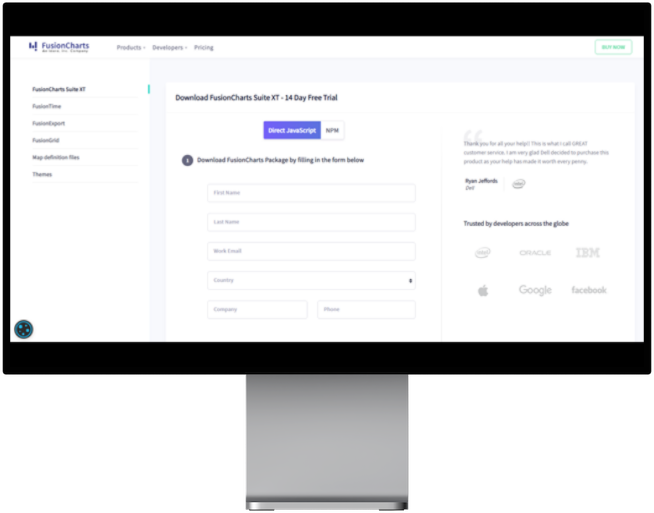An organizational chart displays a company’s internal structure. Boxes or other forms that occasionally include images, contact details, connections to email and web pages, symbols, and illustrations symbolize the personnel and roles. Lines with elbows or straight edges connect the levels. Unfortunately, most individuals are unaware of how to create an organizational chart. Therefore, they are missing out on the benefits of doing so.
Many companies are looking for a suitable jQuery organizational charts library today to build charts for visualization. With the help of the well-known web framework FusionCharts Suite, you may modify your chart in any way you like, whether for practical or aesthetic purposes. For example, you may add layers to the charts using markers, change the charts’ characteristics, or create complex data visualizations using short JavaScript code, among many other advanced capabilities it offers.
This article will examine the definition of organizational charts, their types, and how to make them.
 An organizational chart, sometimes known as an org chart, is a graphic that shows a hierarchy of reporting or relationships. An organizational chart is most often used to display the framework of the firm, agency, organization.
Org charts may be constructed in a variety of ways and are useful for many purposes. They might be used, for instance, as a personnel database, planning tool, or management tool.
An organizational chart, sometimes known as an org chart, is a graphic that shows a hierarchy of reporting or relationships. An organizational chart is most often used to display the framework of the firm, agency, organization.
Org charts may be constructed in a variety of ways and are useful for many purposes. They might be used, for instance, as a personnel database, planning tool, or management tool.
 Any organizational chart’s goal is to make the necessary steps easier to visualize, which is crucial when working on a project. Therefore, charts play a crucial role in data visualization.
Users may more effectively express how they plan to execute business needs for a new process or app using org charts. They may also help you with a process analysis from start to finish. Additionally, each diagram includes tasks, the person responsible for completing them, and the inputs and outputs at each stage.
Furthermore, as the org chart is meant to be clear and transparent, simple, jargon-free language is used. In addition, no matter a reader’s degree of expertise or understanding, the methods are clear-cut and straightforward.
Organizational charts assist in avoiding the omission of important inputs, outputs, and processes in this way.
Any organizational chart’s goal is to make the necessary steps easier to visualize, which is crucial when working on a project. Therefore, charts play a crucial role in data visualization.
Users may more effectively express how they plan to execute business needs for a new process or app using org charts. They may also help you with a process analysis from start to finish. Additionally, each diagram includes tasks, the person responsible for completing them, and the inputs and outputs at each stage.
Furthermore, as the org chart is meant to be clear and transparent, simple, jargon-free language is used. In addition, no matter a reader’s degree of expertise or understanding, the methods are clear-cut and straightforward.
Organizational charts assist in avoiding the omission of important inputs, outputs, and processes in this way.

 Organizational charts may help pinpoint crucial milestones and offer a bigger view of the process when creating and organizing an operation.
There are more than 100 charts and 2000 maps available on FusionCharts. It also includes the available JavaScript charting library with clear documentation, a standard API, and different customization choices. Seven hundred fifty thousand developers are using it globally.
By clicking here, you may now make flow charts to advance your company app after learning about org charts’ types, use cases, and creation in various software programs.
Organizational charts may help pinpoint crucial milestones and offer a bigger view of the process when creating and organizing an operation.
There are more than 100 charts and 2000 maps available on FusionCharts. It also includes the available JavaScript charting library with clear documentation, a standard API, and different customization choices. Seven hundred fifty thousand developers are using it globally.
By clicking here, you may now make flow charts to advance your company app after learning about org charts’ types, use cases, and creation in various software programs.
Table of Contents
What’s An Organizational Chart?
 An organizational chart, sometimes known as an org chart, is a graphic that shows a hierarchy of reporting or relationships. An organizational chart is most often used to display the framework of the firm, agency, organization.
Org charts may be constructed in a variety of ways and are useful for many purposes. They might be used, for instance, as a personnel database, planning tool, or management tool.
An organizational chart, sometimes known as an org chart, is a graphic that shows a hierarchy of reporting or relationships. An organizational chart is most often used to display the framework of the firm, agency, organization.
Org charts may be constructed in a variety of ways and are useful for many purposes. They might be used, for instance, as a personnel database, planning tool, or management tool.
What Is The Purpose Of An Organizational Chart?
 Any organizational chart’s goal is to make the necessary steps easier to visualize, which is crucial when working on a project. Therefore, charts play a crucial role in data visualization.
Users may more effectively express how they plan to execute business needs for a new process or app using org charts. They may also help you with a process analysis from start to finish. Additionally, each diagram includes tasks, the person responsible for completing them, and the inputs and outputs at each stage.
Furthermore, as the org chart is meant to be clear and transparent, simple, jargon-free language is used. In addition, no matter a reader’s degree of expertise or understanding, the methods are clear-cut and straightforward.
Organizational charts assist in avoiding the omission of important inputs, outputs, and processes in this way.
Any organizational chart’s goal is to make the necessary steps easier to visualize, which is crucial when working on a project. Therefore, charts play a crucial role in data visualization.
Users may more effectively express how they plan to execute business needs for a new process or app using org charts. They may also help you with a process analysis from start to finish. Additionally, each diagram includes tasks, the person responsible for completing them, and the inputs and outputs at each stage.
Furthermore, as the org chart is meant to be clear and transparent, simple, jargon-free language is used. In addition, no matter a reader’s degree of expertise or understanding, the methods are clear-cut and straightforward.
Organizational charts assist in avoiding the omission of important inputs, outputs, and processes in this way.
What Are The Four Types Of Organizational Structures?

Functional Top-Down Hierarchy
A hierarchical organizational chart is the pyramid-shaped organizational chart we previously mentioned. The chain of authority runs from the top, such as the CEO, to the bottom, such as entry-level employees, and every individual has a manager. There are several advantages, some of which are as follows:- Improved definitions of degrees of duty and authority
- Demonstrates to whom each individual reports or with whom to discuss particular initiatives
- Provides employees with incentives, including defined career routes and advancement opportunities
- Assigns a specialty to each employee
- Builds camaraderie among staff members working in the same role
- It can cause significant advances to be slowed down by added administration
- Can lead workers to operate in the department’s best interests, rather than the interests of the overall business
- Can give lower-level workers the impression that they have less responsibility and are unable to share their thoughts with the organization
Divisional Organizational Chart
The second kind is typical of big businesses with multiple functional departments. An organization that employs this technique organizes its leadership team according to the projects, subsidiaries, or products they manage. This structure is known as the divisional structure. Johnson & Johnson is a nice illustration of this arrangement. The corporation is organized so that each business unit functions as a separate division with its own director. In addition to specialism, divisions can also be assigned a geographic location. For instance, a multinational firm may include North American and European divisions.Matrix Organizational Chart
A matrix org chart is one of the most intricate, yet most beneficial, organizational charts a business may use. As a result, it is a highly popular choice for many businesses, particularly those in the internet sector. The chart is created using a matrix or grid. Employees report to a line manager and a project coordinator because, in addition to hierarchy, they are organized into teams based on projects. Some advantages of a Matrix organizational chart are:- Professionals and technology can be pooled between projects to achieve a high resource utilization rate
- Formal coordination of projects and products across functional departments
- Since information circulates across the organization, it may move more quickly
- Employees engage in greater interpersonal interactions, which can speed up information exchange and decision-making
- Teams on projects may compete for employees’ motivation
Flat Organizational Chart
There are few to no managerial tiers between “superiors” and employees in a flat company. It encourages more independent decision-making with less oversight. A flat organizational structure increases each employee’s responsibilities inside the company and eliminates extra management levels to enhance communication and coordination. Lower levels of authority improve employee decision-making. In addition, the organization’s budget is increased, since middle management is not required. If a flat organization fails to focus on and explicitly guide team goals and abilities, generalization and misunderstanding are dangerous. On the other hand, when professionals are given the freedom to work on side projects that benefit the business with team support, flat-structured organizations succeed. That entails breaking things up into smaller pieces. Organizations increasingly use the flat structure in many startups to rekindle the entrepreneurial spirit many hierarchical systems tend to lose. Employees are now free to work on tasks they enjoy and are good at, while utilizing the resources and abilities of their coworkers. These initiatives must, however, align with the aims and objectives of the business.Building Org Charts With Popular Software
Users of organizational chart software may make organizational charts of every employee in a business. These technologies are intended to enhance internal communications inside an organization by providing knowledge on present workers. Organizational charts may also clarify team and individual functions within an organization. When planning, managing, and tracking employee labor, HR teams frequently use workforce management systems in conjunction with these solutions. Organizational chart tools have several ways to build and construct the chart. Several programs include prebuilt templates and designs to accelerate the creative process. These products also allow customers to import lists of employees in bulk from spreadsheet applications or upload employee rosters to construct a personnel database with a full-text search system. As a firm expands, these technologies should permit users to create and update organizational charts as well as identify individual positions, sectors, and other information. You can read more on tools to create your charts.Making Of Org Charts In PowerPoint
You can create org charts in PowerPoint using an organizational chart template by following the steps below:
- First, click New in PowerPoint on the File tab.
- Next, enter “org chart” in the box labeled “Search for online templates and themes,” then click “Start the search.”
- Finally, choose an org chart from the search results and click Create.
Making Of Org Charts In Word
You can make an org chart in Word using a template by following the steps below:- First, click on the SmartArt dropdown in the Insert tab.
- Next, click over the Hierarchy flyout and go down the SmartArt menu.
- Pick a layout that suits you.
- When you click the Organizational Chart image, the organizational chart template will automatically be created by Word. The SmartArt Text dialogue will appear. Each box’s contents can be changed directly in the SmartArt Text box or the boxes themselves. Press enter to add a new line of text to the text box.
- The Organizational Chart picture will instantly produce the Word org chart template after you click it. The SmartArt Text dialogue will appear. Each box’s contents may be changed either directly in the SmartArt Text field or the boxes themselves. Press enter to add a new line of text to the text box.
- Right-click (or control + click on a Mac) on the editing plane and select Format Object from the dropdown menu to adjust the style of your organizational chart.
- Change your document’s orientation to a landscape layout if your organizational structure is more horizontal. To begin, select the Layout tab. The Landscape option may then be chosen by clicking the Orientation button.
Making Of Org Charts In Visio From Excel
The procedures below are used to generate a simple org chart using default data fields:
- Point to New on the File tab, choose Organization Chart, then select either Metric or US Units before clicking Create.
- If you want to build a basic organizational chart on your own using the default data fields, click Cancel if you see the Organization Chart Wizard dialogue box.
- You may use several types of shapes to represent members of your organization in the selections on the Org Chart tab according to their positions.
- Drag inferior forms onto superior shapes in accordance with the organizational hierarchy to automatically join the shapes or use the connector shapes to connect manually. Give each member a name, a title, and, if you choose, a member photo.
- Using the different commands and parameters on the Org Chart tab, you may customize the layout of the org chart, the distance between shapes, and the length and width of shapes.
Final Thoughts
 Organizational charts may help pinpoint crucial milestones and offer a bigger view of the process when creating and organizing an operation.
There are more than 100 charts and 2000 maps available on FusionCharts. It also includes the available JavaScript charting library with clear documentation, a standard API, and different customization choices. Seven hundred fifty thousand developers are using it globally.
By clicking here, you may now make flow charts to advance your company app after learning about org charts’ types, use cases, and creation in various software programs.
Organizational charts may help pinpoint crucial milestones and offer a bigger view of the process when creating and organizing an operation.
There are more than 100 charts and 2000 maps available on FusionCharts. It also includes the available JavaScript charting library with clear documentation, a standard API, and different customization choices. Seven hundred fifty thousand developers are using it globally.
By clicking here, you may now make flow charts to advance your company app after learning about org charts’ types, use cases, and creation in various software programs.



